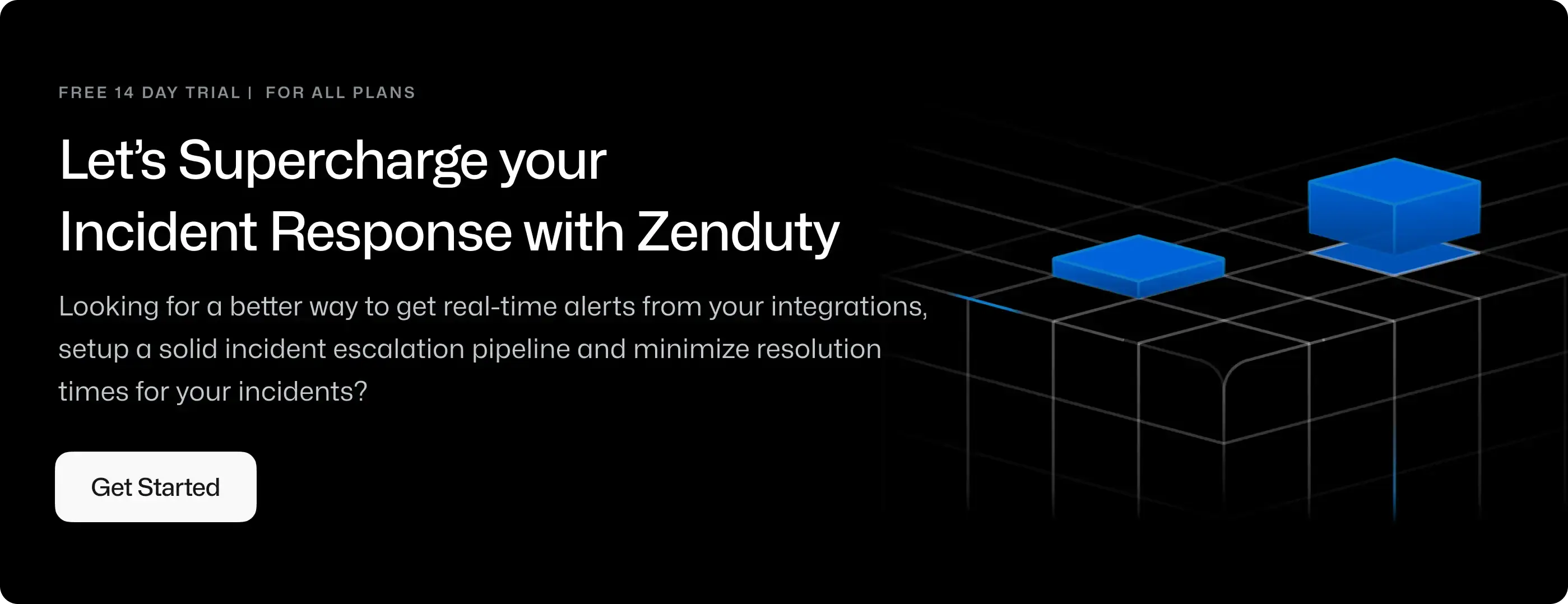Datadog Integration Guide
Datadog is a monitoring service for cloud-scale applications, providing monitoring of servers, databases, tools, and services.
What can Zenduty do for Datadog users?
With Datadog's Integration, Zenduty sends new Datadog alerts to the right team and notifies them based on on-call schedules via email, text messages(SMS), phone calls(Voice), Slack, Microsoft Teams and iOS & Android push notifications, and escalates alerts until the alert is acknowledged or closed. Zenduty provides your NOC, SRE and application engineers with detailed context around the Datadog alert along with playbooks and a complete incident command framework to triage, remediate and resolve incidents with speed.
Whenever Datadog triggers an alert based on a predefined condition, Zenduty will create an incident. When that condition goes back to recovered state on Datadog, Zenduty will auto-resolve the incident.
You can also use Alert Rules to custom route specific Datadog alerts to specific users, teams or escalation policies, write suppression rules, auto add notes, responders and incident tasks.
To integrate Datadog with Zenduty, complete the following steps:
In Zenduty:
- To add a new Datadog integration, go to Teams on Zenduty and click on the team you want to add the integration to.
- Next, go to Services and click on the relevant Service.
- Go to Integrations and then Add New Integration. Give it a name and select the application Datadog from the dropdown menu.
- Go to Configure under your integrations and copy the Webhook URL generated.
In Datadog:
-
Login to Datadog. From the navbar in the left, go to Integrations-> Integrations. Search for Webhooks from this page, and click the corresponding button.

-
Scroll down, click on the +New button in the Webhooks section. Fill in the Name, Webhook URL(copied above) and paste the below in the payload box:
{
"alert_id": "$ALERT_ID",
"hostname":"$HOSTNAME",
"date_posix":"$DATE_POSIX",
"aggreg_key":"$AGGREG_KEY",
"title": "$EVENT_TITLE",
"alert_status":"$ALERT_STATUS",
"alert_transition":"$ALERT_TRANSITION",
"link":"$LINK",
"event_msg":"$TEXT_ONLY_MSG"
}
-
The page should look as below:

-
Click on Save.
-
Now, from the navbar in the left, select Monitors-> Manage Monitors.
-
Navigate to an existing monitor or create a new monitor(learn how). Choose the type of monitor you want to set up, for instance, we choose Metric.


-
Set all the metrics as desired. In the Notify Team tab, make sure to select the Zenduty webhook you have just created.

-
Datadog is now integrated and Zenduty will alert you when Datadog alerts are created and resolved.
FAQs
What notification channels can I route my Datadog alerts to?
Based on alerts received from Datadog, you can notify on-call responders via Slack alerts, Microsoft Teams alerts, e-mail alerts, SMS alerts, Android push alerts and iOS push alerts.
How will incidents and alerts be issued in this integration?
While Datadog monitors your infrastructure and network, Zenduty will create and trigger incidents based on the alert levels and conditions defined on Datadog. According to the severity of the event from the Datadog event payload, Zenduty can create high and low urgency incidents intelligently. When a metric is breached, Zenduty promptly delivers notifications to your on-call responders.
Can Zenduty auto-resolve incidents?
With real-time synchronisation, incidents will be promptly resolved in Zenduty once the metric in Datadog returns to normal, reducing the need for manual intervention.
